Vietnam’s COVID-19 response had been one of the most effective in the world. Its comparatively record low number of cases and deaths and its impressive economic performance during the global pandemic boosted the country’s reputation internationally. A good economic performance boosted the confidence of the Communist Party of Vietnam (CPV) just as it was undergoing a leadership change. A study conducted among 23 countries in May 2020 revealed that Vietnamese respondents recorded the second-highest level of satisfaction after China, with 77% rating positively their government’s response to the COVID-19 crisis. 2020 was also a critical year for Vietnam’s politics, both because of the country’s important diplomatic roles as chair of the Association of Southeast Asian Nations (ASEAN) and non-permanent member of the U.N. Security Council, and because of the once-every-five years Party Congress in early 2021. Moreover, the 13th Party Congress was one of the most important since 1986, when the country embarked on the transformative Doi Moi reforms of renovation, happening amidst political infighting and generational change within the party.
But with the recent surge of the delta variant, paired with shockingly low vaccination rates, public opinion on Vietnam’s performance is beginning to wither.
Like many countries in the region, Vietnam is struggling to contain the spread of the variant, which first arrived in late April 2021. Before delta’s arrival, the country had recorded less than 3,000 cases and 35 deaths over 15 months since the pandemic started in January 2020. But by July 2021, the new case numbers surged to thousands daily and were increasingly hard to control. The highest (to date) single-day record at 9,684 cases on August 8, is equivalent of four times the number of all cases together in Vietnam in all of 2020. The total number of cases is now 220,000 and 3,757 have died, a vast number of whom passed in July 2021. This demonstrates just how dangerous the delta mutation is.
The Vietnamese authorities have been struggling to contain the current spread using the methods it had used before, isolation and monitoring. The numerous outbreaks happened in 63 localities in total, but the largest clusters have been in Ho Chi Minh City and neighboring provinces which are the economic and industrial hub of the country and relatively densely populated regions. Lockdowns imposed since July affect the jobs and livelihoods of many Vietnamese, and put pressure on country’s manufacturing output, affecting global supply chains. The giants of the garment, footwear, and electronic industries, like Adidas, Nike, and Apple, worry about their supplies and prices as the delta wave continues to challenge Vietnam.
Why is the country’s previous effective strategy not coping?
One reason is the delta variant shows a very different transmission pattern than the previous strains. Another is Vietnam’s slow vaccine rollout which can be attributed to a mix of factors.
The government showed a level of complacency — a common trap experienced by many countries that had initial successes in containing the virus, including Australia, Taiwan, and New Zealand. The lack of urgency due to the low infection rates before the arrival of the delta variant made Vietnam slow in securing a vaccine supply. The shortage of vaccines, particularly for less developed countries, further led to Vietnam’s protracted inoculation process. As the delta variant was spreading in India and reaching Vietnam, the CPV was still in undergoing a leadership transition. The 13th Party Congress concluded in early February, but the cabinet positions were not appointed until May and June when the National Assembly conducted its voting. Arguably, that power transition process distracted from and protracted the vaccine procurement campaign amidst global demand.
The authorities also thought they could afford to wait for development of homegrown COVID-19 vaccines, with four in the works: Nanocovax by Nanogen, Covivac by the Institute of Vaccines and Medical Biologicals (IVAC), and two others from the Vaccine and Biological Production Company No. 1 (Vabiotech) and the Center for Research and Production of Vaccines and Biologicals. Nanocovax, which passed three phases of human trials, is expected to seek emergency approval soon and be available by late this year.
Vietnam is not alone in being short on vaccines. In fact, Vietnam’s case illustrates the difficulties of fighting the pandemic with limited resources. The strong governance can help control the spread, but when it comes to the subsequent phases of response, resources are essential to secure vaccines. Like most developing countries, Vietnam lags behind the developed countries that were able to secure vaccines much earlier and are in more advanced phases of immunization.
When the pandemic started, most of the international debate focused on which governance systems are more effective in containing the virus: autocracies or democracies. Notwithstanding the problematic framing of this debate, the 2020 pandemic did demonstrate effectiveness of more centralized governments that commanded greater authority as well as enjoyed trust of their people. Beyond the ability to “flatten the curve,” however, is the ability of the governments to inoculate their populations. The 2021 pandemic shows that the real divide is between the “haves” and “have nots.” While developed countries lead in inoculation, and some even moved to “booster shots,” many in the developing world still struggle with vaccine shortages.
Vaccines have also become a vector of great power competition, so donations have become an important source. Vietnam is among the lower-income countries that received, relatively to its Southeast Asian peers, less external assistance. Indonesia, Philippines, and even much-smaller-by-population Cambodia received more vaccines donated by China much earlier. Throughout the pandemic, Vietnam has not received health equipment, masks, and personal protective equipment donations from China like its neighbors. Chinese diplomats made trips to Indonesia, Malaysia, Philippines, and Cambodia on a regular basis but shunned Vietnam. For one, Vietnam had dealt with the virus well, but tensions over the South China Sea arguably could have played a role.
To date, Vietnam received 1.5 million doses of the Sinopharm vaccine (500,000 donated in June and 1 million purchased in July), but according to a statement by the Vietnamese Health Ministry the vaccines would be used for Chinese citizens in Vietnam, people from Vietnam who have plans to work or study in China, and people who live near the borders with China. A level of apprehension towards Chinese products is also common among the Vietnamese and some have pointed to distrust as a factor of not obtaining more Chinese-produced vaccines. It is true that Hanoi is wary of the geopolitical implications of being over-reliant on China’s vaccines. But in reality, Beijing’s generosity towards Vietnam also has been slim.
The vaccine roll-out was significantly slower, and only really took off in July. As of mid-August, only 1% of the population is fully vaccinated with two doses, and 7.7% with at least one dose. The newly announced national inoculation strategy expects to complete vaccinations of 70% of population by mid-2022.
Vietnam launched the Vietnam Fund for Vaccination and Prevention of Coronavirus Disease, a $1.1 billion public fund to secure 120 million vaccine doses by the end of the year. The government has also begun asking for public donations to support the fund. By early June the fund had secured $180 million from more than 230,000 organizations and individuals, including Samsung and Toyota.
The extremely contagious delta variant challenges Vietnam’s previously effective response to the pandemic. The slow vaccine rollout and rampant transmission of the new mutations of the virus has particularly complicated Vietnam’s ambitious economic plans. Although Vietnam’s early 2021 economic performance was strong (with GDP growth 6.6% for the second quarter), prognostics after June are grimmer, as factories in the country’s key industrial areas reduce capacity due to the outbreak. Economic performance and projections are likely to be negatively affected if shutdowns continue. The weaker response to delta affects Vietnam’s international reputation and the domestic confidence in the regime, and makes for a troubled start for the government’s new leadership.
As of mid-August, a total of 17.9 million vaccines doses had arrived in Vietnam. This included over 11 million AstraZeneca doses donated by Japan, Australia, and the U.K. and procured by the government, 5 million doses of Moderna donated by the United States, and 1.5 million doses of Sinopharm given by China. An optimistic outlook suggests that Vietnam will be able to turn around its vaccine shortage by becoming a vaccine producer. In July, Vietnam successfully produced a test batch of Russia’s Sputnik V vaccine. It is also in talks with the U.S. for technology transfer and seeking to become a mRNA-based vaccine technology hub.
Vietnam has become a textbook example that, regardless of how successful their COVID-19 response strategies had been in the past, countries remain vulnerable. As the new variants will continue to mutate, COVID-19 management strategies need to be constantly reviewed and adapted accordingly. Accelerating vaccination is imperative for securing human security, economic recovery, and political confidence.
-
Acknowledgements and disclosures
Adrien Chorn provided editing assistance on this piece.
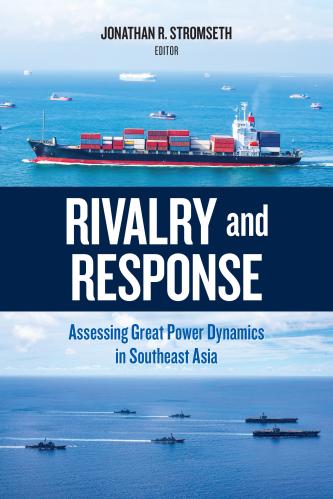
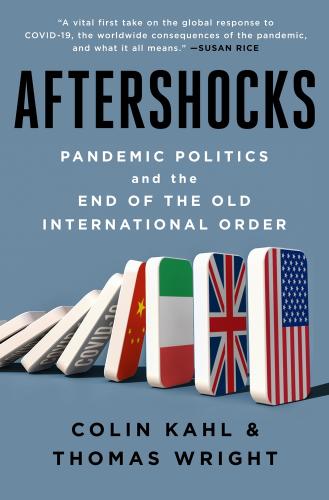
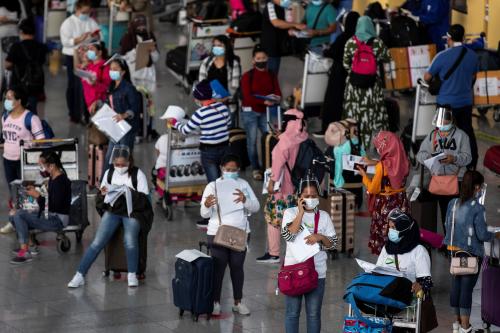
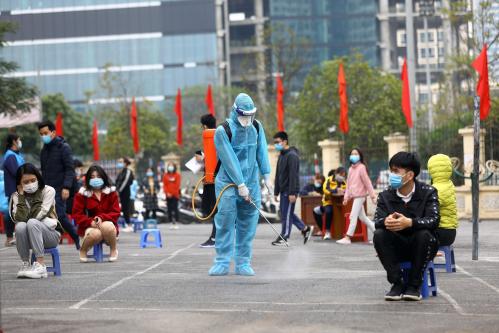
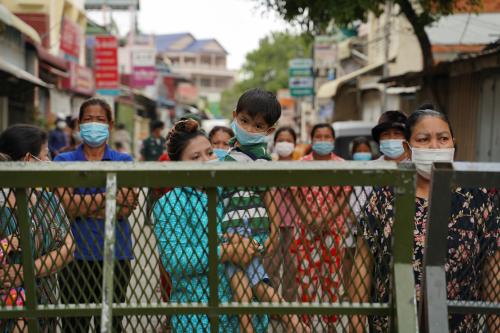

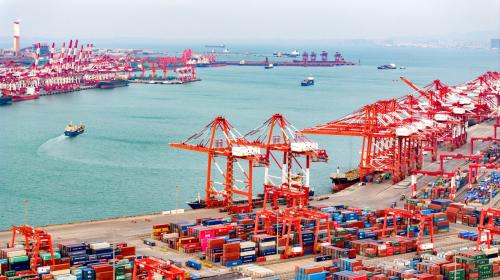
Commentary
Delta variant outbreak challenges Vietnam’s COVID-19 response strategy
August 11, 2021